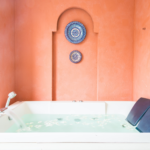
As the vibrant hues of autumn sweep in and temperatures begin to dip, your hot tub can become the perfect sanctuary for warmth, relaxation, and comfort. However, cooler weather also means your hot tub will work a bit harder to maintain its ideal temperature, potentially increasing energy use. With some smart hot tub hacks, you can boost efficiency, enhance comfort, and make the most of your soak this fall without worrying about soaring energy bills. This guide offers practical, season-specific tips to help you enjoy your hot tub throughout the crisp autumn months.
Keep Your Hot Tub Covered When Not in Use
One of the most effective ways to conserve heat and save energy during autumn is to always keep your hot tub securely covered. A high-quality, well-fitting hot tub cover acts as an insulating barrier, preventing heat from escaping into the cooler air. Locking or fastening the cover down not only helps retain warmth but also keeps debris like falling leaves out of the water, reducing maintenance. Inspect your cover for signs of damage or sagging foam core, and replace it if it no longer fits snugly or retains heat well.
Optimize Your Hot Tub Temperature Settings
It’s tempting to keep your hot tub at the highest temperature year-round, but lowering the thermostat slightly when not actively soaking can save energy without sacrificing comfort. Experts recommend setting the water temperature to around 95°F when the tub is idle and raising it to between 100°F and 104°F just before use. Many hot tub models feature economy or sleep modes designed to regulate temperature efficiently, activating heating only when necessary.
Maintain Clean and Efficient Water Circulation
Proper maintenance is the cornerstone of an efficient hot tub during any season, but especially in fall when more organic debris like leaves and pollen tend to collect. Regularly clean or replace your hot tub filters to ensure unobstructed water circulation. Clogged filters make your hot tub’s pump and heating system work harder, wasting energy and reducing overall comfort. Cleaning filters once a month or as recommended by the manufacturer will keep your system running smoothly and economically.
Inspection and Maintainance
Your spa heater is the heart of your hot tub’s temperature control, and keeping it in peak condition helps prevent excessive energy use. Efficient spa heaters consume less power to maintain warmth, saving you money over time. During autumn maintenance, inspect the heater for leaks, corrosion, or signs of wear, and contact a professional for repairs if needed. Also, consider upgrading to an energy-efficient model if your current unit is outdated or inefficient.
Use a Thermal Blanket Beneath Your Cover
For an extra layer of insulation, place a thermal blanket on the water surface before securing your hot tub cover. This simple addition reduces heat loss directly from the water, meaning your heater expends less energy to maintain the temperature. Thermal blankets are lightweight, easy to use, and particularly beneficial during cold nights or extended periods of non-use.
Schedule Heating During Off-Peak Hours
If your electric utility offers time-of-use rates, schedule your hot tub to heat during off-peak hours when electricity costs are lower. Many hot tubs have programmable timers or smart controls that allow you to set heating schedules. Heating the water during these cheaper periods can result in significant savings on your monthly energy bill while ensuring your spa is ready for use when you want it.
Maintain Water Chemistry and Balance
Keeping your hot tub’s water properly balanced reduces wear on components and maintains water clarity so that the filtration system doesn’t need to work overtime. Test pH, alkalinity, and sanitizer levels regularly, adjusting as necessary to prevent corrosion or scaling on pipes and heaters. Balanced water prevents mineral buildup that can insulate heating elements, forcing them to run longer and consume more power.
Protect Your Hot Tub from Falling Leaves and Debris
Autumn naturally brings falling leaves and other debris, which can clog filters and affect water quality. Regularly remove leaves from the water surface with a skimmer and clear the area around your hot tub to prevent debris from entering. Using a hot tub cover when not in use is critical here, but additional steps like strategically placed barriers or landscaping can also reduce maintenance needs.
Add Comfort Features for Cozy Autumn Soaks
Maximize your autumn hot tub experience by incorporating comfort features that enhance relaxation despite cooler weather. Consider adding cushioned seating or insulating spa pillows to keep you comfortable while soaking. Surround your hot tub area with warm lighting, such as LED string lights or lanterns, to create an inviting atmosphere. Adding a nearby infrared heater or portable fire pit can provide warmth when stepping in and out of the tub, making transitions easier on chilly evenings.
Keep Hydrated and Moisturized
Hot tubs can dehydrate skin due to warm water exposure combined with cool, dry autumn air. After soaking, nourish your skin with rich, hydrating lotions containing natural oils like coconut or shea butter. Staying hydrated by drinking water before and after use also helps maintain your overall comfort and wellness during extended hot tub sessions.
Enjoy the beauty of fall colors around your warm, inviting soak, all while keeping energy costs down and extending your hot tub’s lifespan. With these tips, your hot tub will remain the ultimate autumn retreat—cozy, efficient, and always ready when you are.
Image Source: Freepik



